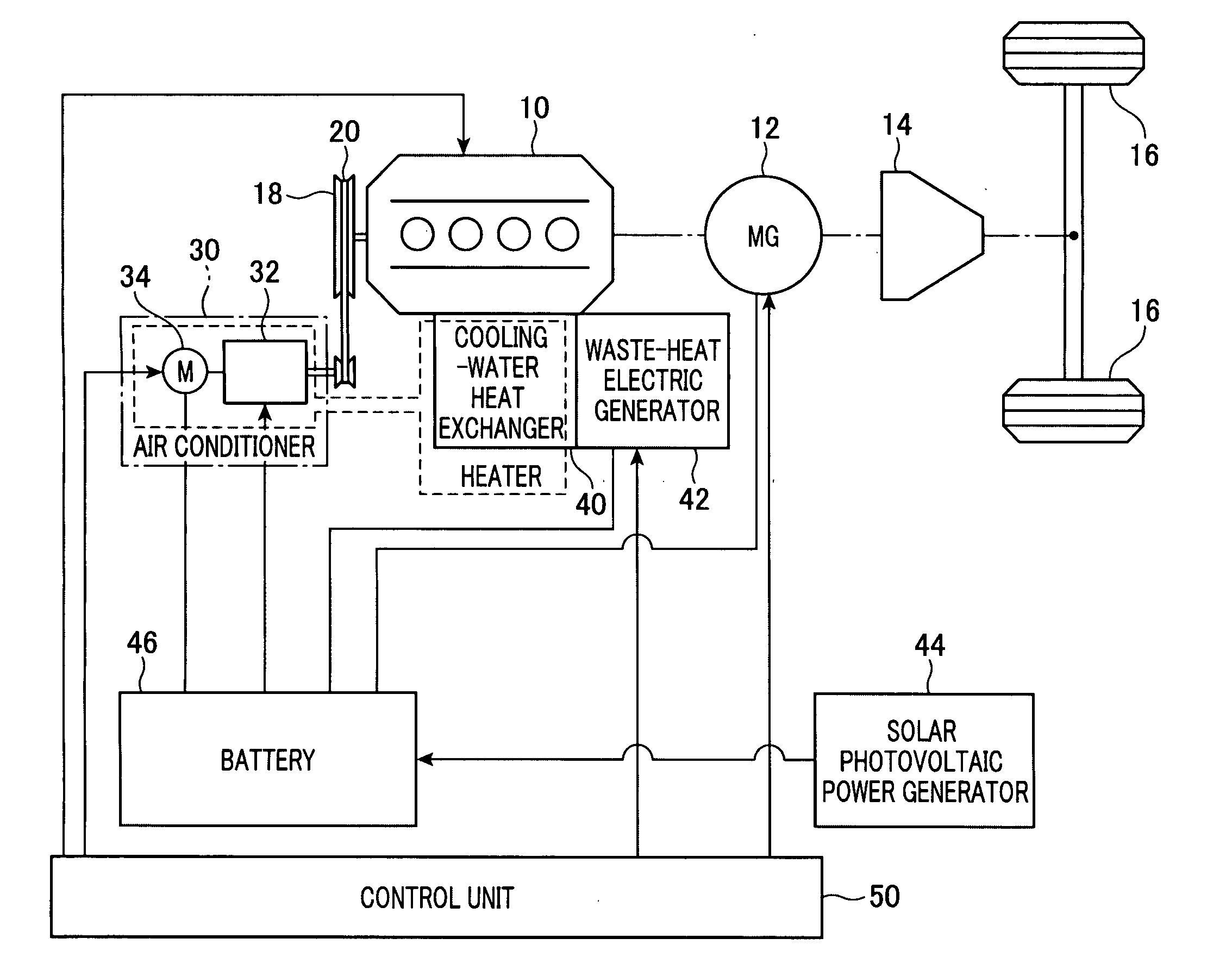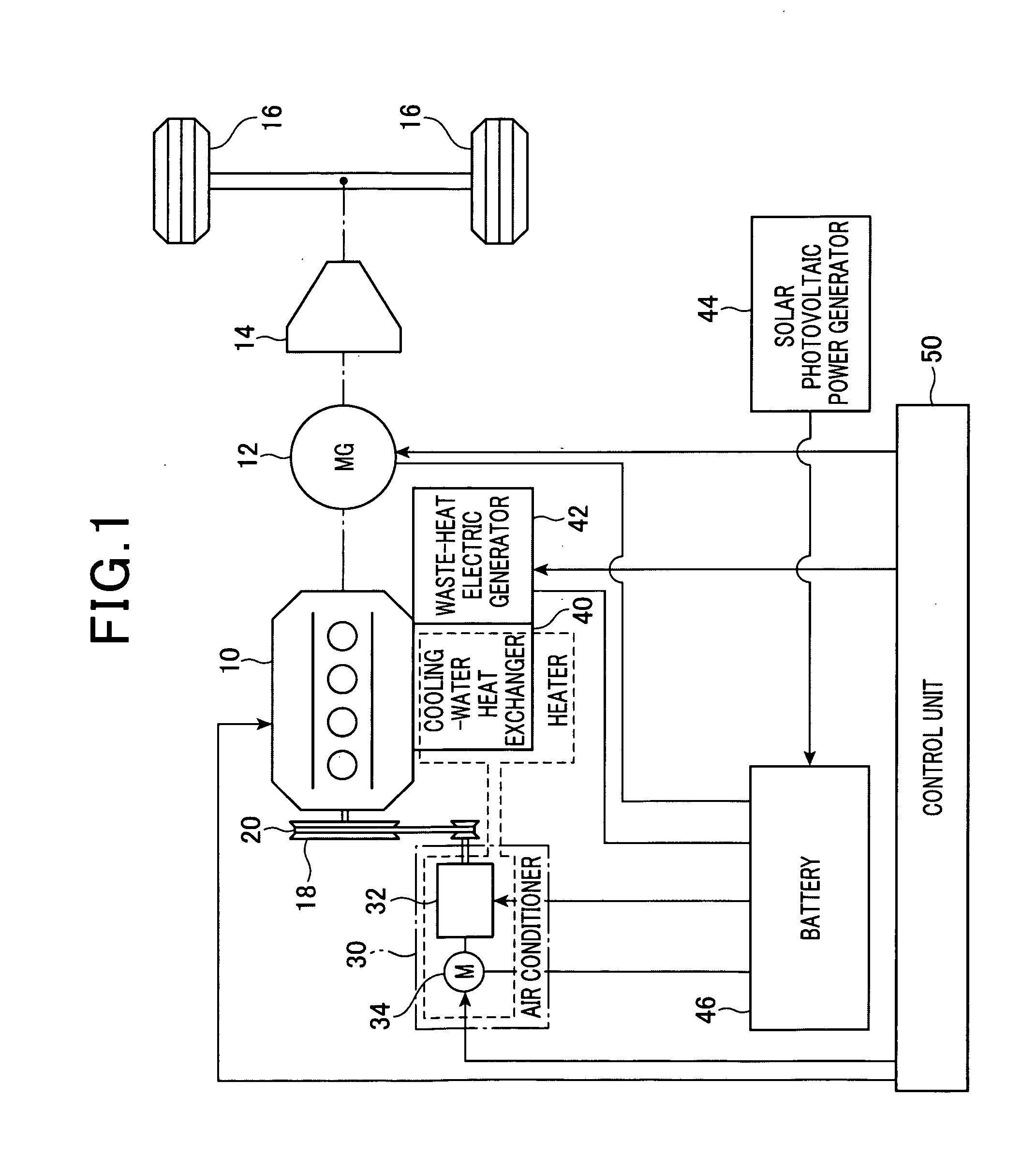Apparatus for managing energy supplied to functional device units realizing a specific function
- Summary
- Abstract
- Description
- Claims
- Application Information
AI Technical Summary
Benefits of technology
Problems solved by technology
Method used
Image
Examples
first embodiment
[0073]First, referring to FIGS. 1 to 6, hereinafter is described an energy management apparatus according to a first embodiment of the present invention. In the first embodiment, the energy management apparatus is applied to a parallel-hybrid vehicle.
[0074]FIG. 1 is a schematic diagram illustrating the energy management apparatus according to the first embodiment. As shown in FIG. 1, the energy management apparatus includes an engine 10, motor-generator 12, transmission 14, drive wheels 16, pulley 18, belt 20, on-vehicle air conditioner 30, compressor 32, motor 34, cooling-water heat exchanger 40 (hereinafter just referred to as “heat exchanger 40”), waste-heat electric generator 42, solar photovoltaic power generator 40, battery 46 and control unit 50.
[0075]The engine 10 is an internal combustion engine that functions as an on-vehicle main engine. The engine 10 has a rotary shaft (crank shaft) which is directly connected to a rotary shaft of the motor-generator 12. The motor-genera...
second embodiment
[0131]With reference to FIG. 7, hereinafter will be described a second embodiment of the present invention, focusing on the differences from the first embodiment. It should be appreciated that, in the second and the subsequent various embodiments, the components identical with or similar to those in the first embodiment are given the same reference numerals for the sake of omitting explanation.
[0132]In the second embodiment, the average cost CE of the electric power domain is coupled with future prediction information of the environments where the vehicle concerned will be situated.
[0133]FIG. 7 shows a procedure of calculating the average cost CE, according to the present embodiment. For example, this procedure is repeatedly performed at a predetermined cycle.
[0134]In a series of processes in the procedure, it is determined, at step S60, whether or not environmental information of near future (e.g., future of several minutes to two hours later) is available. The environmental inform...
third embodiment
[0139]With reference to FIG. 8, hereinafter is described a third embodiment, focusing on the differences from the first embodiment.
[0140]Use of the waste-heat heater may raise a problem if the engine 10 has not been warmed up. The problem in this case is that sufficient heat may not be obtained until the engine 10 is warmed up. Therefore, in this case, the efficiency of the engine 10 is lowered in order to secure heat in a transition period preceding a quasi-equilibrium state (quasi-static state). Then, the engine efficiency is gradually raised to calculate the system cost. However, such a calculation may increase the calculation load of the control unit 50.
[0141]In this regard, in the present embodiment, the engine 10 is assumed to be in a quasi-static state when waste-heat heating is estimated while the engine 10 is stopped. Thus, the calculation of the cost that will be incurred in the system can be simplified.
[0142]FIG. 8 shows a procedure of selecting a functional device unit t...
PUM
 Login to View More
Login to View More Abstract
Description
Claims
Application Information
 Login to View More
Login to View More - R&D
- Intellectual Property
- Life Sciences
- Materials
- Tech Scout
- Unparalleled Data Quality
- Higher Quality Content
- 60% Fewer Hallucinations
Browse by: Latest US Patents, China's latest patents, Technical Efficacy Thesaurus, Application Domain, Technology Topic, Popular Technical Reports.
© 2025 PatSnap. All rights reserved.Legal|Privacy policy|Modern Slavery Act Transparency Statement|Sitemap|About US| Contact US: help@patsnap.com



